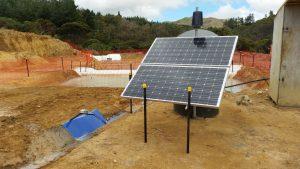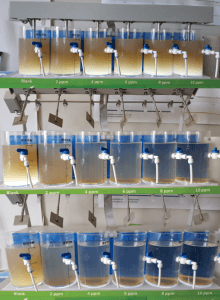Sediment Control
Coagulants and flocculants
What, why, when, and issues to look out for
What
This type of treatment involves adding reagents to sediment-laden runoff to increase the rate of settlement of fine soil particles. It should only be done by trained and experienced people. The treatment relies on two basic processes, coagulation followed by flocculation:
- Coagulation
- uses charges to clump particles together (coagulate), forming larger heavier particles.
- Flocculation
- makes suspended sediment particles in liquids come together to form larger, heavier particles or ‘flocs’, that settle faster. Flocculants improve the sedimentation and filterability of small particles
Flocculation happens after coagulation. For effective sedimentation, you need to use both tools.
There are different reagents available. The one you choose, and the way you choose to apply it, depends on the soils on-site and the design of the sediment retention device. In all cases, you will need to bench test a variety of reagents to establish which option is most appropriate for sediment removal at your site and to protect the receiving environment. Uphold Mana Whenua values by preferring organic alternatives where practical. Choose the one that affects the receiving environment the least.
Why

A flow-activated system delivers precision dosing of dirty water flows into sediment retention tools (Source: RST Solutions Limited).
When left to nature, the physical and chemical properties of suspended clay and loess particles mean that they settle very slowly. To get good water quality you will usually need to speed this process up for your project. By adding coagulation then flocculation reagents you will make the particles join together and settle much faster, improving the efficiency of your sediment retention devices.
When

Bench testing of flocculants to determine the most effective at the lowest concentration, an essential step (Source: Erosion Control Limited).
Do a ‘bench test’ to gather information on which coagulants and flocculants will work best for your particular soil, and the optimal dosage rate at which to apply them. A bench test involves collecting a sample of the earthworks site’s soil, mixing it with water in a clear cylinder and measuring the time that the suspended sediment takes to settle, with help from the ‘floc’. If there are a range of soil types on your site, or in soil profiles, then collect samples of them all for testing.
During the bench test, the sample of dirty water for testing is split equally into at least 6 containers. Different concentrations of coagulant/flocculent is added to each one, and then stirred.
Try combinations of different reagents to determine which single, or combination of products work best to treat the dirty water runoff on your site.
Record the time it takes for the sediment in each sample to drop out of suspension. Measure the pH of the water (after the water has had time to mix effectively), so you know whether the water is within the effective pH range for the reagent you are trying. This will also help you know whether the treated water in your pond or bund will be acceptable to discharge.
Coagulation and flocculation must not damage the receiving waterway, so only discharge treated water that has a pH of between 6.5 and 8.0. Look at TP227 (PDF 783 kB) for more information.
Record which concentration of reagent/s provided the best water quality at the lowest concentration in the bench test. This will be the concentration of reagent to use in the treatment of water on site.
You should normally always treat sediment retention ponds and decanting earth bunds to achieve the best water quality possible.
Issues to look out for
Treatment has the following limitations:
- When using PAC you should stop treatment when the pH drops below 5.5 or rises above 8.5.
- You need to do a lot of monitoring and maintenance. Keep testing for pH and water clarity to understand how your pond or runoff is performing. Don’t just add more floc!
- Spills of reagents can have significant adverse effects on the receiving environment.
- In significant rainfall (>15 mm in 24 hours), you need to carefully monitor the rate of use so that the system doesn’t run out of reagent.
- Do not just add more reagent if treatment isn’t quite working or seems to be taking a long time. If this happens, stop and systematically work out why your reagent isn’t being effective. For example, check the pH of the pond water to ensure that it is within the effective range for the reagent. If it isn’t within the working range of the reagent you may need to re-balance the pH of the water so the system works well. Consult a suitably experienced professional for advice.
Because of the above limitations, only implement treatment under the supervision of a suitably experienced and qualified person.
Treatment options
PAC
The guidance in this toolbox refers to poly aluminium chloride (PAC) as the main example of a reagent, because it is the best understood one at present. PAC can be used as a solid or liquid – the liquid is normally a 33% solution in water.
It has a general dose rate of 31–155 ml/m³, which adds 2–10 ppm of aluminium. Consider buffering the pond with gypsum or lime to bring the pH to the operational pH range for the floc, if needed. You can expect dissolved aluminium to be ~1 part per million when pond water pH is within required range for effective treatment with PAC. If pH in the pond water is very low (outside the effective range for PAC), then aluminium may be present in concentrations toxic for aquatic life. If this happens, be prepared to hold the water until you have got it to a safe pH. Consider sampling for dissolved aluminium in the discharge water to show that it is acceptable for the receiving environment. Be aware that samples for dissolved aluminium need to have insoluble aluminium hydroxide filtered before analysis.
Other options
Sites differ significantly in their soils, water and receiving environments, so PAC may not be the most effective reagent in all situations. For each project, you need to bench test alternatives. Keep researching other reagents. There may be other reagents that are effective for the soils on your site that have a lower risk of effects in receiving waterways, so check out all options to find the best one. We will update this toolbox as understanding of the use and effects of other reagents develops.
Most flocculants are available in liquid or solid (granulated) form, allowing dosing by a flow-activated system, a rainfall-activated system, a floc (geosynthetic) sock or batch dosing. Gypsum can also have an important part to play. Always use the lowest effective concentration of floc to achieve good water quality in the pond.
For flocs other than PAC, eg chitin-based products, their operational pH range can be narrower than PAC’s, making it important to understand the floc requirements and the water’s pH. Check whether pre-dosing your dirty water with gypsum improves floc performance.
Flocs vary in their ease of preparation for use and ability to be stored, so follow advice from your supplier.
Include the details of alternative reagents and dosing procedures for each site in the Flocculation Management Plan (FMP) – also known as a Chemical Treatment Management Plan (CTMP).
Evaluating treatment performance
Once your chemical treatment system is set up and running, you’ll need to check that it is effective and safe under the live operating conditions. This is an essential part of the process, so expect Compliance Monitoring Officers to check that this is being carried out.
This means taking samples during rain storms of the dirty water flowing into ponds or bunds and re-checking the effective dose rate of reagent. Take samples of dirty water before reagents are added by your set up and recheck the effective dose rate. Repeat this over several storms – the concentration of sediment in runoff can vary as earthworks and excavations progress.
Keep records of the checks and update your chemical treatment management plan with this information. Make sure everyone involved in this part of the work knows about the changes by including this in your toolbox talks. Keep your Compliance Monitoring Officer informed of the changes you are implementing.
Safety
Keep the Material Safety Data Sheet (MSDS) for each reagent you use, and review and implement the health and safety requirements at all times.
You will need to store bulk reagent on site to replace used reagent. Store it according to standard practice for hazardous materials – specifically, in a secure, bunded facility. Either cover the bunded area to avoid rain collecting or do regular maintenance to drain rainfall that is collected, to maximise the capacity of the bunded area for containing spills.
Store the reagent at each pond site in a locked shed. Unopened drums may be stored beside the shed to facilitate refilling, especially over winter, but only keep what is reasonably needed stored like this. Locate and store them in a way that minimises the risk of spills.
Transport reagent to and from the project according to the required hazardous goods, traffic and transport regulations.
On site, transport the reagents in sealed containers, securely retained within the site vehicle. These containers should be small enough that they can be easily handled. Only transport the expected required volume at any one time.
Use reagents in accordance with the site Health and Safety Management Plan.
Decommissioning
When you are decommissioning a treatment system, you need to remove any remaining reagent. Salvage it for reuse where possible, but don’t mix it with fresh reagent.
Remove and disposed of all accumulated sediment correctly. Returning sediment to the land may be the best option, provided it itself does not become a source of sediment to waterways or dust. If it cannot be disposed of like this, make sure it is disposed of in a lawful way, for example, to a consented landfill.
Remove the shed and tanks from site and store them for reuse (note: if you reuse a treatment system on a different site, you will need to modify it).